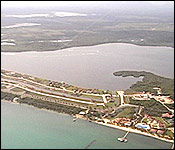
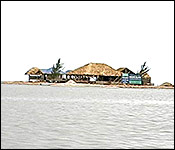
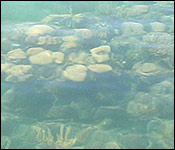
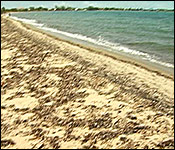
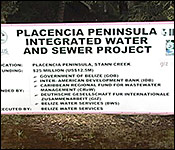
 Last night, we showed you small excerpt into our coverage of a developing situation on the Placencia Peninsula. It involves what happens when residents and visitors flush their toilets.
Last night, we showed you small excerpt into our coverage of a developing situation on the Placencia Peninsula. It involves what happens when residents and visitors flush their toilets.
The conservationists say that there is strong evidence to suggest that the human waste is slowly polluting the lagoon. We went down to Placencia with our friends in the conservation community to examine the situation for ourselves. Daniel Ortiz reports:
Daniel Ortiz reporting
The Placencia Peninsula... It's one of those areas in the country which is experiencing rapid expansion in the number of residents, and new developments.
For Placencia Village itself, this community, like the other tourism destinations, is also expanding its tourism business to try to attract as many visitors as possible.
But, with all that expansion, come corresponding growing pains, one of them being the concern of just too many houses, hotels, resorts, restaurants and businesses, all clamoring for limited space on the peninsula.
The peninsula also has the gift and curse of being surrounded by a lagoon.
And that's why conservationists believe that the traditional septic tank systems, native to inland communities, is a slowly-timed environmental hazard waiting to happen.
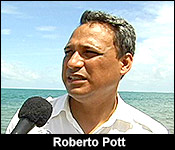 Roberto Pott - Country Manager, Healthy Reefs For Health People Initiative
Roberto Pott - Country Manager, Healthy Reefs For Health People Initiative
"We've seen that over the last 10 years or so, where we've gone up from about 10 percent fleshy macro-algae cover in the region to about 23 percent; and that's almost a 10 percent increase. We're confident that's related to nutrients coming in from the rivers as well from sewage management systems. The fleshy macro-algae serves as an indicator that we are already seeing a lot of the nutrients coming on and how that impacts on the environment is that it allows or provide more nutrients for the algae to grow faster and grow more and continues to cover coral areas that would have been able to maybe get recolonized by corals that were reduced back in the early 2000s, late 1990s when we had huge areas of bleaching followed up by hurricanes, the way Placencia did in 2000 by Hurricane Iris that devastated this community. The community has rebounded but the coral has been slow. Because it's now competing with the algae for space. And so that's the impact that we saw and that brings our attention to where the source of that nutrients is and we believe and we are fairly confident that its coming out from septic tanks which is the predominant way of handling sewage on the islands as well as on the main lands."
Linda Thorton - Representatives, Shrimp Growers Association
"What I see that I am concerned about is that I understand they do have some new laws in place that new developments have to have their own self-contained waste water treatment. But I see many of the other small people that are buying older homes and maybe smaller resorts in the village and are refurbishing or upgrading them so they can sell them for more money, but they are putting more and more homes and rooms and sewage systems in the forms of septic tanks on very small places of land and I think there has to be more regulation. It just seems that maybe a piece of land that originally belong to a Placencia family that originally had two or three small homes on it, how it has ten cabanas and each cabana have a septic tank and we know that tourists use a lot more water than we do."
But, that can be avoided, if an integrated sewage system is built to dispose of the village's waste away from the Lagoon. That waste water can be carefully extracted and treated further inland, thereby reducing and removing the danger.
Roberto Pott - Country Manager, Healthy Reefs For Health People Initiative
"Belize City is one of the few that has a sewage treatment or remediation ponds. San Pedro has one. From the last statistics we got, there are only 50% of the households connected to that sewer system. So there are a range of issues around handling or sewage in these urban and developing areas."
The problem is one such system was proposed and even announced - back in 2011. 4 years later, construction has not started. The project faced one serious challenge: the Shrimp Farmers would have been negatively affected.
 Linda Thorton - Representatives, Shrimp Growers Association
Linda Thorton - Representatives, Shrimp Growers Association
"When they were talking about the waste water treatment which we believe is needed. The one problem we had was the remediation ponds, were going to be on the back side, where the discharge of that would go directly into our intakes for our shrimp farms and even though it would reduce the sewage, it's taken all the sewage from a large area and concentrated it in one small area. So even if was say 100,000 gallons and it was cleaned up by 95,000 gallons, 5,000 gallons of waste would still be coming directly in our ponds and it would basically shut down our industry. So we understand the need for it and we want to encourage it, but we want to have it designed where it will benefit everyone and hurt the other industries."
For those concerned individuals, they are hoping that the authorities haven't forgotten what's at stake. There is the island's Tourism Industry, and its Shrimp Farming operations, which earned over a hundred million dollars last year for Belize. These two important operations continue to hang in the balance.
Linda Thorton - Representatives, Shrimp Growers Association
"We have not met engineers from BWSL. When they were considering in putting in the waste water treatment facility in this area and they showed us microbiological tests of the area and its very scary, because lots of the creeks and the back of the lagoon which do not get the water exchange from a tidal influence are very high in certain levels and even though maybe the discharged around the peninsula is more in the front, but the sea water is diluting it, moving it out. So we are extracting water from the lagoon that are going into our ponds and the higher this level gets, the more we are at risks that it would show up into the tissues of the animals and when the shrimp are process, the laboratory at the processing facilities will tests for the this. If they are at a certain level we would not be able to sell it. We would have to throw it away. Now this is an industry in this area that we employed over 1,200 people, in the Stann Creek/Toledo area. In 2014, we produced over 17 million pounds of shrimp and that brought in about 100 million Belize dollars. So it's a very significant impact."
Roberto Pott - Country Manager, Healthy Reefs For Health People Initiative
"Some of the information comes out of a Halcrow report in 2012 that asses the water quality in the lagoon around Placencia, which justify the need for a sewage management plant and what it was already showing is that we have high E.coli and it's not only a threat to industries like the shrimp farms, but it would a direct impact on health and the health of visitors that come to Belize. If that starts getting out on the windward side of Placencia, and so there is an urgent need for sewage treatment plants in Placencia and the other destinations - Belize City as well. Worst case scenario is that we would lose our reef and that would be hard to recover from."



